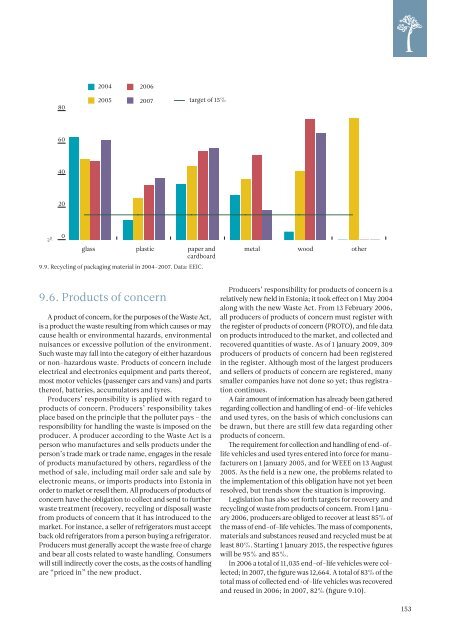ESTONIAN ENVIRONMENTAL REVIEW 2009
ESTONIAN ENVIRONMENTAL REVIEW 2009
ESTONIAN ENVIRONMENTAL REVIEW 2009
You also want an ePaper? Increase the reach of your titles
YUMPU automatically turns print PDFs into web optimized ePapers that Google loves.
2004<br />
2006<br />
80<br />
2005<br />
2007<br />
target of 15%<br />
80<br />
60<br />
60<br />
40<br />
40<br />
20<br />
20<br />
%<br />
0<br />
glass plastic paper and<br />
cardboard<br />
9.9. Recycling of packaging material in 2004–2007. Data: EEIC.<br />
metal wood other<br />
0<br />
9.6. Products of concern<br />
A product of concern, for the purposes of the Waste Act,<br />
is a product the waste resulting from which causes or may<br />
cause health or environmental hazards, environmental<br />
nuisances or excessive pollution of the environment.<br />
Such waste may fall into the category of either hazardous<br />
or non-hazardous waste. Products of concern include<br />
electrical and electronics equipment and parts thereof,<br />
most motor vehicles (passenger cars and vans) and parts<br />
thereof, batteries, accumulators and tyres.<br />
Producers’ responsibility is applied with regard to<br />
products of concern. Producers’ responsibility takes<br />
place based on the principle that the polluter pays – the<br />
responsibility for handling the waste is imposed on the<br />
producer. A producer according to the Waste Act is a<br />
person who manufactures and sells products under the<br />
person’s trade mark or trade name, engages in the resale<br />
of products manufactured by others, regardless of the<br />
method of sale, including mail order sale and sale by<br />
electronic means, or imports products into Estonia in<br />
order to market or resell them. All producers of products of<br />
concern have the obligation to collect and send to further<br />
waste treatment (recovery, recycling or disposal) waste<br />
from products of concern that it has introduced to the<br />
market. For instance, a seller of refrigerators must accept<br />
back old refrigerators from a person buying a refrigerator.<br />
Producers must generally accept the waste free of charge<br />
and bear all costs related to waste handling. Consumers<br />
will still indirectly cover the costs, as the costs of handling<br />
are “priced in” the new product.<br />
Producers’ responsibility for products of concern is a<br />
relatively new field in Estonia; it took effect on 1 May 2004<br />
along with the new Waste Act. From 13 February 2006,<br />
all producers of products of concern must register with<br />
the register of products of concern (PROTO), and file data<br />
on products introduced to the market, and collected and<br />
recovered quantities of waste. As of 1 January <strong>2009</strong>, 309<br />
producers of products of concern had been registered<br />
in the register. Although most of the largest producers<br />
and sellers of products of concern are registered, many<br />
smaller companies have not done so yet; thus registration<br />
continues.<br />
A fair amount of information has already been gathered<br />
regarding collection and handling of end-of-life vehicles<br />
and used tyres, on the basis of which conclusions can<br />
be drawn, but there are still few data regarding other<br />
products of concern.<br />
The requirement for collection and handling of end-oflife<br />
vehicles and used tyres entered into force for manufacturers<br />
on 1 January 2005, and for WEEE on 13 August<br />
2005. As the field is a new one, the problems related to<br />
the implementation of this obligation have not yet been<br />
resolved, but trends show the situation is improving.<br />
Legislation has also set forth targets for recovery and<br />
recycling of waste from products of concern. From 1 January<br />
2006, producers are obliged to recover at least 85% of<br />
the mass of end-of-life vehicles. The mass of components,<br />
materials and substances reused and recycled must be at<br />
least 80%. Starting 1 January 2015, the respective figures<br />
will be 95% and 85%.<br />
In 2006 a total of 11,035 end-of-life vehicles were collected;<br />
in 2007, the figure was 12,664. A total of 83% of the<br />
total mass of collected end-of-life vehicles was recovered<br />
and reused in 2006; in 2007, 82% (figure 9.10).<br />
153

















